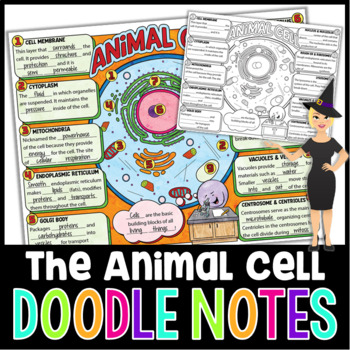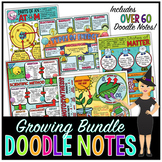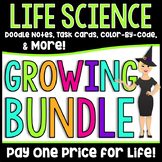Animal Cells and Organelles Doodle Notes | Science Doodle Notes
- Zip
What educators are saying
Also included in
- These science graphic organizers include a range of topics from life science, physical science, earth & space science, chemistry, and general science.What does a growing bundle mean?Purchasing this growing bundle means that you save 20% on all current resources in the bundle, any updates to thePrice $259.99Original Price $358.82Save $98.83
- These science graphic organizers include a range of life science topics including human body systems, photosynthesis, cellular respiration, animal and plant cells, Punnett squares, food webs, energy pyramids, classification, cell theory, reproduction, and more!What does a growing bundle mean?PurchasPrice $89.99Original Price $121.11Save $31.12
- If you are looking for a one-stop shop for middle school life science resources, you came to the right place! This growing bundle offers a wide range of activities and topics that will make teaching life science a breeze. I've also included my Scientific Method Doodle Notes as a bonus!What does a grPrice $199.99Original Price $259.61Save $59.62
Description
This science graphic organizer includes illustrating the animal cell and identifying and describing cell organelles including cell membrane, Golgi body, endoplasmic reticulum (smooth & rough), mitochondria, nucleus, nucleolus, ribosomes, lysosome, cytoplasm, centrosome, centriole, vacuoles, and vesicles. This fun, NO PREP activity will have your students mastering content quicker, easier, and asking for more!
Interested in a digital version?
Animal Cell and Organelles - Digital Version
With what standard does this resource align?
This resource will aid students in moving towards mastery of the Next Generation Science Standard NGSS MS-LS1-2.
What are doodle notes?
Doodle notes are a visual aid that will increase student concept retention, focus, creativity, and engagement. Students will gain experience in synthesizing information and creating their own tangible connections in their notes.
What do I have to do?
These doodle notes are no prep! Print which version of the doodle notes is most appropriate for your students (easy differentiation!) and use my provided notes or your own. I have included a PowerPoint slide show that includes the answers to the fill-in-the-blank notes. I have also included a student quiz to easily assess student mastery of the doodle notes content.
What is included?
⭐ 1 Fill-in-the-blank-version - use this version for students who struggle with taking notes, ELL students, or reluctant learners.
⭐ 1 Blank doodle note for using your own notes - this version has my artwork, but not the notes for more independent learners and students who enjoy writing their own notes. You can also use this version with your own notes.
⭐ 1 Completed example of the doodle note - Use my completed example as a mini anchor chart for your lesson or to share with students.
⭐ Student reading passage - this reading passage contains everything your students need to complete the doodle notes. Have students read and underline key passages to help them with reading comprehension and to figure out how to complete the fill-in-the-blank notes.
⭐ PowerPoint slides for the fill-in-the-blank notes - this resource is partially editable! You can take out my notes and replace it with your own, the clip art and headings are not editable. Use this with whole class instruction or set it up for individual students to use in stations. The notes are self-guiding and easy to use.
⭐ 1 Student quiz with teacher key - use these as exit tickets or as a summative assessment when students have completed their notes.
How do I use doodle notes?
• Teacher led note taking
• Student led note taking
• Independent research or homework
You might also be interested in:
Plant Cells and Organelles Doodle Notes
Connect with me
My Blog: www.themorehousemagic.com
Instagram: @themorehousemagic
Facebook: The Morehouse Magic
"Doodle Notes" is a trademarked term. Used with permission. Please visit www.doodlenotes.org for more information.








